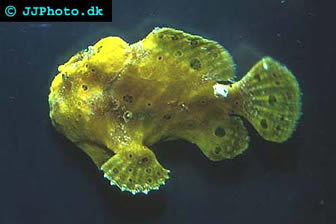Anglerfish
The angler fish can catch impressively large prey since it is equipped with a jaw capable of distending, thin and flexible bones and a stomach that can be heavily expanded. The combination of these features makes it possible for the anglerfish to swallow and digest fishes twice its own size.
The anglerfishes belong to several different families in the order Lophiiformes, such as Lophiidae and Ogcocephalidae. A majority of the known species of anglerfish live far down in the aphotic parts of the sea. (Aphotic = without any light. The sunlight cannot penetrate down to the aphotic parts of the ocean and no photosynthesis can therefore occur at these depths.) Since they live at such great depths, we still know very little about them. Some families of anglerfish have species that occurs in more shallow water, e.g. the family Antennariidae which is home to the frogfishes, the family Chaunacidae which is where you will find seatoads (coffinfishes), the family Lophiidae with its goosefish (monkfish) and the family Ogcocephalidae where some of the New World species inhabit coastal waters and estuarine environments.
How big is an Angler fish?
A lot of people want to know how big (or small!) an angler fish can be, but answering that question is hard because the maximal and minimal size varies a lot among the 200 known species of anglerfish. The sex of the fish will also be of vital importance. Before we can answer the question “How big is an angler fish?” or “How small can an anglerfish be?” we must therefore ask another question: “Which anglerfish do you mean?”
A group of deep sea living anglerfishes received a lot of attention when the flabbergasting size difference between males and females was unveiled by researchers. Since these creatures live at such a great depth, they are used to a pitch dark environment lit up only once in a while by the occasional bioluminescent vampire squid or viperfish. Finding a suitable mate in such a murky setting is naturally tricky and some anglerfishes have therefore developed a remarkable relationship between the two sexes. Once a male and female fish finds each other in the gloomy depths, they will never let go again. The male has no digestive system and as soon as he finds a female of his own species he will attach himself to her and start excreting a special enzyme. The enzyme will make the body of the female fish accept the male instead of expelling him and they will gradually merge together. The male will link his blood system to the blood system of his partner; thereby removing the need for him to catch any prey.
So, what does this have to do with the size of an angler fish? Well, it would be really difficult and impractical for the female to have a male fish own her own size attach to her. The male fish is therefore much, much smaller than his partner – typically between 4 and 6 inches (10-15 cm) while free swimming. As soon as he has attached himself to a female he will start to shrink and become even smaller. The female on the other hand can be at least 36 inches (90 cm) in size.
To correctly answer the question “How big is an anglerfish?” one must therefore know not only the species but the sex as well.
Anthias
Aquarium Chillers
Basses
Batfish
Blennies
Butterflyfish
Cardinalfish
Clown fish
Corals
Damselfish
Files
Goatfish
Gobies
Gorgonians
Grammas
Groupers
Grunts
Hawkfish
Jawfish
Jellyfish
Lionfish
Dragonets
Mantis shrimp
Marine angelfish
Marine Catfish
Moray eels
Nudibranch
Octopus
Pipefish
Protein skimmers
Pufferfish
Rabbitfish
Rays
Snappers
Scorpionfish
Sea Anemones
Sea horses
Sea Stars
Shark Fish
Shrimps
Snails
Squirellfish
Surgeonfish
Triggerfish
Wrasses

